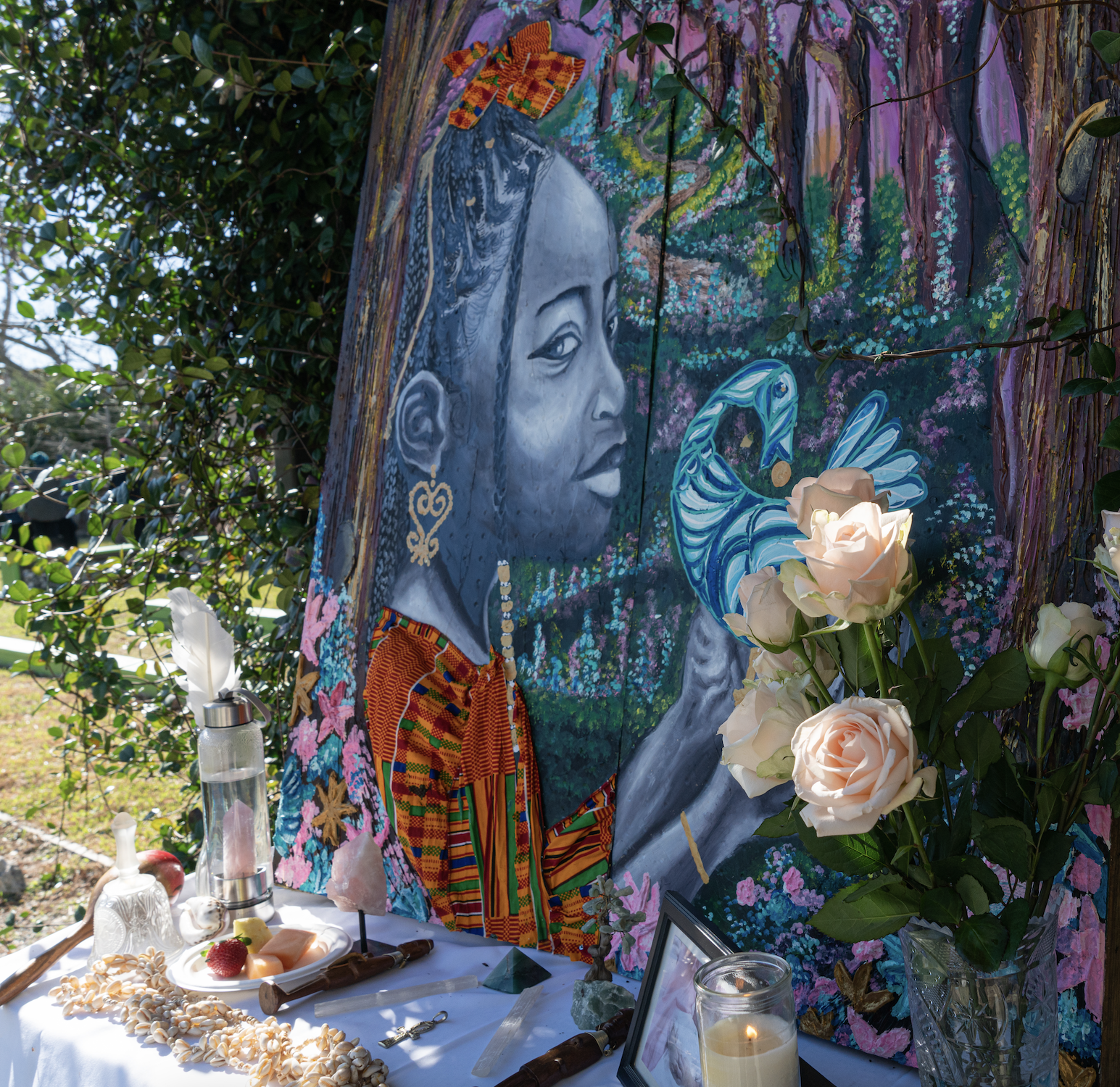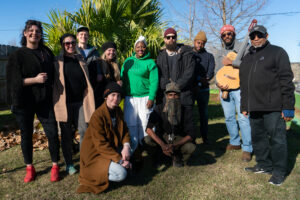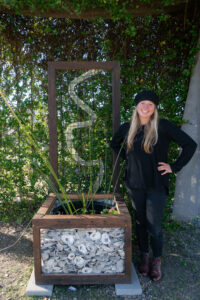Summary
"Placeholder" was a community art gathering held in the Lower Ninth Ward. It was a collaboration between the Center for Sustainable Engagement and Development, BODYART Dance and Changemaker Catalyst Award recipient Rachel Slater Carter.
Changemaker Catalyst Award recipient and Mellon Fellow, Rachel Slater Carter, worked with the Lower Ninth Ward Center for Sustainable Development and Engagement and BODYART Dance for the past year to co-produce a new community art event, Placeholder, with hopes it will become an event series.
In New Orleans, blighted properties, overgrown ruins and astonishing holes in the road are unavoidable. Here, the process of decay is sped up: extreme and visible.
The seeds of Placeholder were sown several years ago when the Lower Ninth Ward Center for Sustainable Engagement and Development (CSED) CEO Arthur Johnson and BODYART Artistic Director and Tulane Associate Professor, Leslie Scott, first began a conversation. They asked “Where does art intersect with community engagement?” and “What are the psychological impacts of ongoing urban blight on cultural identity?” I entered the discourse as a Mellon Fellow and BODYART associate artist. While the work is ongoing, we have become a “we”. As community leader Carol Bebelle says, developing a collective identity, or “we” consciousness, requires “solidarity, collective identity, shared commitment and cause.”
While answering the questions often drove our interactions, the conversations took on a life of their own. I became Project Manager, employing my previous experience as an artist, producer and event organizer to bring Placeholder to fruition. In January 2023, we presented the original work of local artists Alina Allen, Lissie Stewart, SWINE, and Jason Meserole in a public event attended by community members of the Lower Ninth, Tulane folks and artist colleagues from around New Orleans.
Addressing the psychological impacts of blight is a priority for both organizations. Art might not be what some think of when it comes to disaster recovery, yet we believe that community-engaged artmaking bolsters an area’s healing, fortitude and resilience. Art is noted to be a culture bearer. It can catalyze change, root traditions and channel zeitgeist. Art can inspire hope and provide a safe outlet for expression. Early in the process of development, I noticed a glaring discrepancy: to read about the Ninth Ward, it would be an empty place, full of rampant crime, devoid of young folk, businesses and growth. It is written of as if the effects of Hurricane Katrina are just as fresh as they were one year after the storm. While the extensive damage from Katrina and the ongoing mismanagement of recovery funding and efforts is evident, it is not a wasteland. There are new businesses popping up. A new community center. Several community gardens. Houses being rebuilt on high stilts, and friendly folks sitting on their porches. There is energy in the Lower Ninth. The longer I worked with CSED, the more I wanted to celebrate and amplify the work that is already happening there. Work is coming from the inside out – strengthened from the core and the guts of the community who live there. 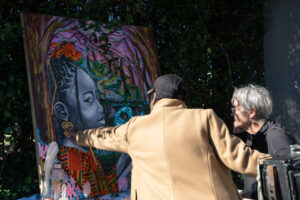
Placeholder was held at the CSED’s Environmental Learning & Research Center. Once 5 separate lots, this composite property acts as an outdoor classroom and work site for many neighborhood activities. Once the venue was selected, one of our first lines of research was into the exact history of the lots. They are no longer blighted properties, now working together as a valuable chameleon of a place. In many instances of blight, the details of a space’s history have been washed away with the former structures. It was important to us that we began by honoring the past. This approach is translatable across fields as honoring lived experiences and oral histories just as much as what one might find on a current map or in a textbook. Along with showcasing the artists’ pieces, a history of the lots was displayed during Placeholder.
Working closely with CSED’s Arthur Johnson, and employees Roland Black, Christina Lehew, Natalie Manning and Arlo Townsley, Placeholder went from an intangible idea to a fully produced event featuring the work of local artists. It was attended by community members from the Lower Ninth Ward, as well as from the New Orleans arts scene such as Music Box Village, BODYART Dance, Tulane’s Dance Department and Mellon Fellowship, Dancing Grounds and the families and friends of the artists. Brazilian Jazz guitarist Geovane Santos’ beautiful melodies rolled over the gathering, along with a memorable collaboration with the 6-year-old niece of artist Alina Allen. They played, sang and dance a rendition of “Baby Shark”. The continued emphasis on and commitment to personal relationships and trust has been paramount throughout the entire process of creating Placeholder. In my opinion, genuine community engagement must be built upon personal relationships, trust and reciprocity to succeed.
Each artist added a unique and important perspective to our jambalaya. I am proud and grateful to have hosted a cadre with such depth and range for our initial Placeholder event.
Lissie Stewart’s work fell naturally in line with CSED’s environmental mission. She creates her sculptures and mixed media work with entirely recycled and natural materials and runs a community garden and composting center. She is “moved by efforts of individuals to intentionally cultivate land and restore Louisiana’s wetlands and diminishing coastline.”
SWINE’s work is colorful, surrealist, and made entirely of found materials such as sheet rock, chalk and driftwood. His name stands for Sick Wandering Individuals Neglected Everyday and in his own words, “I tell stories of people just like you that have struggled with acceptance & that familiar feeling of rejection that we have all faced at some point throughout our journey.” 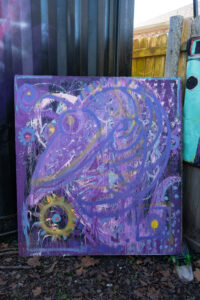
Both lifelong New Orleanians, Alina’s and Jason’s work often illustrate the essence of life in NOLA. Alina can often be found at Jackson Square, while Jason is a regular presenter at the Art Market on Frenchman Street. Alina says of her art: “Being a black woman I believe it is imperative that I paint black people! My inspirations derive from stories of my ancestors and I interpret it in a beautiful light.” Her exquisite original work for “Placeholder” , Sankofa, tells the story of her young niece, and currently lives at the CSED’s main office. Meanwhile, Jason came to painting by accident. He was a musician who found his visual medium during the early days of the pandemic when live events paused. His work “is inspired by music, strength, & community.” They reflect musicians, instruments, swamplands and many other New Orleanian mainstays in vibrant colors evident of life in the Crescent City.
Photographer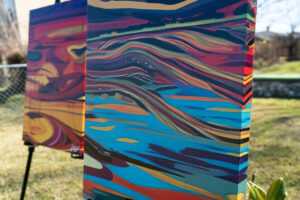 and Mellon Fellow, Felli Maynard, captured Placeholder live. Additionally several Tulane undergraduates assisted in the research, planning and execution of the event: Ari Renai, Maya Jamunapati, Julianne Crawford, Kenneth Barngrover and Owen Orthwein.
and Mellon Fellow, Felli Maynard, captured Placeholder live. Additionally several Tulane undergraduates assisted in the research, planning and execution of the event: Ari Renai, Maya Jamunapati, Julianne Crawford, Kenneth Barngrover and Owen Orthwein.
Placeholder was related to positive social change and innovation through its nature – an event focused on celebration and caring, nurturing and growth. Placeholder held space for the community to come together. It was created by common goals, ethical practices and a shared commitment. As Arthur Johnson said “This is the first but not the last. A place for people to sit and talk and engage together in so many different ways. Over the environment, through art, intergenerational and cross-city. You couldn’t ask for anything better.”
Placeholder Reel
Film by Maya Jamunapati
